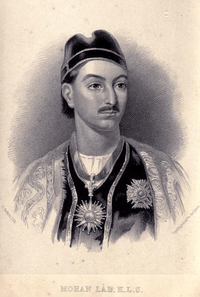Mohan Lal (Zutshi)
| Mohan Lal (Zutshi) | |
|---|---|
 | |
| Born | 1812 |
| Died | 1877 |
| Occupation | traveller, spy, diplomat, and author |
Mohan Lal Zutshi (Kashmiri: मोहन लाल) (popularly known as Mohan Lal Kashmiri; 1812 – 1877) was a traveller, diplomat, and author. He played a central role in the First Anglo-Afghan War of 1838–1842. His biography of Dost Mohammad Khan, emir of Kabul, is a primary source on the War.
His wife Hyderi Begum was a Muslim and a scholar. During the Indian Mutiny in 1857, she maintained a day book recording vividly the happenings and events in Delhi. Her diary was later seized and confiscated by the British government.
Mohan Lal retired at the age of 32, disappointed that he had not been properly rewarded for his singular contributions to the British cause in the First Anglo-Afghan War. His only brother, Kedar Nath Zutshi, who was a Deputy Collector at Ambala died in 1855. Mohan Lal's later years were spent in obscurity and financial troubles. He is believed to have written an extensive diary, but it has disappeared.
Anglo-Afghan war
In 1831 Lieutenant (later Captain) Sir Alexander Burnes of the East India Company's service was deputed by the British Government to gather information in the countries lying between India and the Caspian. He was directed to appear as a private individual with a small retinue maintaining a character of poverty. Mohan Lal was engaged by Burnes primarily to assist him in his Persian correspondence and also because Burnes believed that his youth and creed would free him from all danger of his entering into intrigues with the people among whom he was going to travel.
Alexander Burnes and Mohan Lal led an expedition to Central Asia in 1832-4 for procuring political and military intelligence, and became firm friends. Later, Lal was the Commercial Agent for the British on the Indus and Political Assistant to Burnes in Kabul during the first Afghan War. Unlike Burnes, he survived the massacres of 1841 and continued to keep Calcutta informed of events in the Afghan capital from the house of a merchant where he had taken refuge. His reports contained many strong and cogent criticisms of the behaviour of British Officers, and particularly Sir William Hay Macnaghten and General William Elphinstone.
Mohan Lal had learnt Persian in Delhi and travelled in the garb of a Muslim, under the pseudonym of 'Aga Hassan Kashmiri' or as 'Mirza Quli Kashmiri' in Iran and Afghanistan collecting information vital for his British masters. During the First Anglo-Afghan war he was instrumental in setting up and expanding the British intelligence network in Afghanistan and is also alleged to have had a major hand in arranging the assassination, by poisoning, of Mir Masjidi Khan, a major Afghan resistance leader.[1] He found out and handed over to the British authorities secret letters written by the rulers of Kandahar to Mehrab Khan, the ruler of Baluchistan, exhorting him not to allow passage to the invading British army. He managed to obtain the services of very important functionaries like Mohammed Tahir, Haji Khan Kakari, Abdul Majeed Khan, Akhundzada Ghulam and Mullah Nasooh in Kandahar and Sardar Abdul Rashid Khan, a nephew of the Emir Sardar Dost Mohammad Khan in Ghazni. He played a major role in securing the release of British prisoners held hostage in Bamiyan. He tried to bring peace between the British and the Afghans during such inflammatory situations.
Opinions
Mohan Lal made a telling observation to Burnes about British imperialism: "You all tell yourselves all sorts of fairy stories – you are here to sell us your wonderful British goods, you want to set us free, you want us to grow up, you want to educate us and make us worship three gods instead of forty thousand… but when you are old and tired and sleeping in a thousand years' time, you will start to realise that you came here and took possession of what was not yours for one reason. To surrender it, to give it up. That is the only reason."
References
- ↑ Lady Florentia Sale, Journal of the Disasters in Afghanistan, 1841-42, 1843, p.141
Books
- Mir Ghulam Mohammed Gubar : Afghanistan in the course of History [Persian] second Edition Qum Iran Published 1359 [1979-80] p-454,550
- Alex. Burnes : Travels into Bukhara. Vol.1
- Lal, Mohan. Journal of a tour through the Pun jab, Afghanistan, Turkistan, Khorasan and part of Persia in company with Lt Burnes, and Dr Gerard (Calcutta, 1834)
- Lal, Mohan. Travels in the Punjab and Afghanistan and Turistan to Balkh, Bikhara and Herat and a Visit to Great Britain, Germany (1846) (Reprinted Lahore: Al Biruni, 1979)
- Lal, Mohan. Life of the Amir Dost Mohammed Khan, of Kabul: with his political proceedings towards the English, Russian, and Persian governments, including victory and disasters of the British Army in Afghanistan. (London: Longman, Brown, Green and Longmans, 1846)
- Victoria Schofield, 2003, Afghan Frontier: Feuding and Fighting in Central Asia, Tauris Parke Paperbacks, ISBN 1-86064-895-9, ISBN 978-1-86064-895-3.
Biography
- Gupta, Hari Ram. Life and Work of Mohan Lal Kashmiri. (Lahore: Minerva Book Shop, 1943).
Photograph
- Photograph at the Wayback Machine (archived October 28, 2009) from Archived October 28, 2009, at the Wayback Machine.
External links
- Face of Afghan spy revealed in forgotten photo; Gallery uncovers 150-, Sunday Herald, The, Apr 21, 2002, by Juliette Garside.